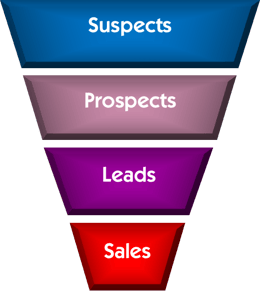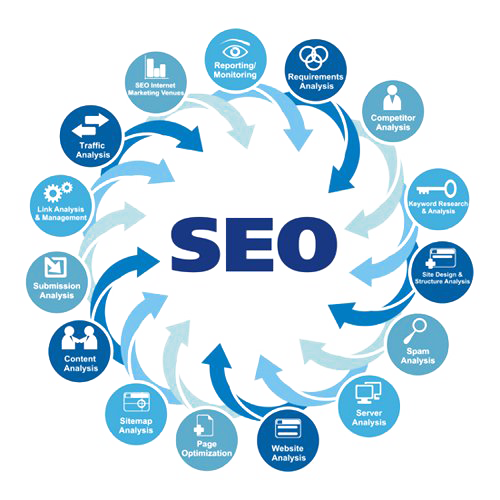
Digital marketing has become a vital part of business marketing today. The information technology sector is an extremely competitive industry, spanning a wide range of different areas in a very large and growing market. So, if you run a tech company and want to stand out from the competition, online marketing is crucial, and getting it right is even more important.
Digital Marketing Overview
Digital marketing is complex and it encompasses many strategies. Understanding the basics and how to generate qualified leads that spark business growth can be a real challenge. In addition, there is no way to improve results if you do not have the right tracking tools and mechanisms in place.
Likewise, these complexities are compounded by long sales cycles that require a well-defined sales funnel in order to move prospects from one stage of the customer journey to the next. Common stages might include lead generation, conversions, consideration and decision-making.
In this article we delve into digital marketing activities tech companies should deploy to get the best results from their digital marketing budget.
Digital Marketing Essentials
1. Digital Marketing PlanA digital marketing plan is a document outlining a company’s online marketing goals, strategies, timelines, channels, and budget. It serves as a roadmap that guides a firm’s actions, decisions and expectations regarding its digital marketing activities.
Since the document serves as a guide, without it, a business wouldn’t know where it's headed, the steps involved, and the resources it takes to get there. Likewise, they have no way to check if their plan met its goals or not.
Tech companies who want to succeed online must have a sound digital marketing plan that details their goals, strategies, and the execution of the plan to achieve these goals.
A proper digital marketing plan requires:
- Understanding your audience: the plan should include a deeper understanding of your audience, their behavior, and expectations to position your products and services to meet their needs.
- Staying consistent: the plan outlines what you need to do to achieve your goals. This is critical in keeping your marketing activities aligned with well-defined goals and being able to define success by comparing goals to actual results.
- Using resources more efficiently: the plan ensures that resources are channeled to activities that yield tangible results and help control spending on items such as content, multimedia, ads and other marketing activities.
- Budgetary controls: Every plan should include a detailed budget that assigns costs to each digital marketing activity. This should act as a guide to how much should be spent on each channel.

A good digital marketing plan should be comprehensive enough to cover every aspect of your business and include the following components:
- Situational analysis
- Digital marketing goals
- Digital strategies and tactics
- Measurable results, goals and KPIs
These components cover the essential pillars of effective digital marketing including planning and governance, goals and measurement, media, content, experience, and conversational messaging. These tips will help you create an effective digital marketing plan that is both cost-effective and fuels growth.
2. Funnel Marketing StrategyA marketing funnel is a visual representation of the process a visitor takes from their first visit to your website until the time they convert into a customer. The funnel features multiple stages involving capturing, guiding, and nurturing prospects through the various stages of purchasing and narrowing down into each stage of the funnel in order to deliver the right messaging, content and information at each stage of the customer journey.
 Image courtesy of https://favpng.com
Image courtesy of https://favpng.com
Funnel marketing functions as a unified whole implying that every step of the journey needs to work for the entire process to be successful. Ideally, it should be a marketing cylinder since it's every business’ goal to turn each lead into a successful customer, but many factors are involved in each stage hence the funnel and not a cylinder.
Though there are many variations, the following are the stages of a typical B2B marketing funnel:
- Awareness: This is the uppermost stage of the marketing funnel involving making potential customers aware of a problem and potential solutions.
- Consideration: Now that the buyer wants a solution, they start to collect information and share it with other stakeholders.
- Evaluation: At this stage, a number of products are being considered for the solutions and evaluated per their competitive advantage
- Purchase: After comparing the pros and cons of the competition, a decision must now be reached regarding the Purchase Order.
Now that you’ve understood the process it takes to turn leads into customers, it's time to create your marketing funnel strategy. Note that you want to include funnel marketing into your digital marketing plan and make the funnel as automated as possible.
B2B SEO marketing involves creating and optimizing pages on your website to rank higher on search engine results. It targets the searches made by managers, executives, or other key decision-makers within companies. That’s why it's important to understand the search intent as well as the keywords used by your target audience.
Here are the major components to include when formulating an SEO strategy:
- Formulate the key questions to address
- Perform a thorough competitive analysis
- Declare SEO goals and establish a roadmap of how to get there
- Select which topics to focus on and how to build content around them
- Define how campaign performance is measured and define KPIs
 image courtesy of https://favpng.com
image courtesy of https://favpng.com
Before you formulate your B2B SEO strategy, ask yourself these questions: What is your target audience looking for? How are they going to find it? What is their search intent? What keywords are they using in their searches?
Having answered these questions, the next step would be to produce a content plan that will improve rankings and increase organic traffic to your website.
4. Digital Content Strategy
The digital content strategy involves utilizing content (text, audio, and/or visual) to achieve your marketing goals. It focuses on your goals, target audience, voice, and content types, to ensure you create, produce, and promote content aimed at contributing to your bottom line. The digital content strategy covers all the digital marketing channels such as social media, SEO, blogging, podcasts, emails and video.
It is important to select content topics that match your digital marketing goals and SEO strategy. This is usually done by creating a Content Cluster web page or blog post, that covers all the topics that you would eventually like to write about, making sure that the cluster topics match your keyword goals.
Likewise, the strategy must also account for what type of content is served to prospects during each stage of the buyer’s journey and how to deliver the right content to the right people at the right time.
Digital content strategy is essential for online marketing. To understand its importance, think of it as a soccer game that has defined rules and strategies for success. If a team doesn’t follow these rules and strategies they’re bound to fail. Digital content strategy acts as the rules and strategies in online marketing. It plays a critical role in converting your marketing exertion into revenue from conversions.
Before getting started with your strategy, it is important to master the art of the game and follow the right framework. The following steps can help:
- Establish content goals
- Audit existing content
- Research competitors’ content
- Create a digital editorial calendar
Once you have a good understanding of the content in your organization and the type of content that is popular with your target audience you can come up with an effective content strategy.
5. B2B Blogging
B2B blogging is an essential and powerful marketing tool for most businesses since today’s consumers go online to shop or search for professional goods and services. This is true for both businesses and individuals. Blogging helps attract more traffic to your website in a cost-effective, reliable, and scalable manner. It also serves as a way to help refine what topics matter the most to your audience. That knowledge can, in turn, turn anonymous visitors into engaged and hopefully converted leads.
B2B blogging remains one of the most effective formats for distributing content to your audience including both customers and prospects. Most blogs have similar structures For example, a target audience of software developers may expect code samples that would not be interesting for a general audience.
One of the goals of a blog is to attract a loyal following. Understanding the fundamental components of a B2B blog can be helpful in making this happen:
- Informative well-written content
- Style and tone according to audience
- Clear and compelling headlines
- Catchy introductions to hook the reader
- Striking visuals that complement the content
- Appealing designs and layouts
- Clear and convincing calls to action
Once you are ready to start your blog, you need to develop a strategy based on your research topics and target keywords. The next step is to create a Digital Content Calendar and then start producing content accordingly. Once the content is approved it needs to be published on your website and social media platforms. It is also advisable to promote your blog posts on various platforms to ensure maximum exposure.
6. Improving Google Rankings
Ranking higher on Google can be frustrating and incomprehensible. An unimaginable number of websites exist, yet, Google somehow compares these sites and determines which one is the most important and deserves the top spot in its ranking. How does this work?
Google uses a fully-automated ranking system utilizing web crawlers that are always crawling and indexing hundreds of millions of web pages and other content to present the most relevant and useful results in the fastest time possible. Numerous factors are involved in Google’s search algorithms’ ability to give you the most useful information. Some of the main parameters include:
- Search intent
- Subject relevance
- Page usability
- Domain authority
- Geographical location
- Browser settings
It should be noted that Google doesn’t accept payment for higher page rankings which is done programmatically. While companies can pay for ads that appear before the ranked results, it takes effort and the right strategies to achieve a higher ranking. Here are some great tips on ways to organically improve Google rankings:
- Capitalize on on-page and technical SEO
- Create internal links
- Target less competitive keywords
- Match search intent
- Improve bounce rate
- Include meaningful visuals
That said, it is well that Google is constantly updating and changing its algorithm to improve the quality of its search results. The changes can be frequent or infrequent and range from minor to major updates. So, it's important to always try and stay informed about the latest changes to their algorithm and how that can affect rankings.
7. B2B Social Media Tactics
Social media is vital to B2B marketing. Companies need to be active on social media because that’s where their customers, industry analysts, journalists and business partners can be found. Social media campaigns can be used to drive website traffic, enhance brand identity, increase customer loyalty and even improve SEO rankings.
 Photo by Piotr Cichosz on Unsplash
Photo by Piotr Cichosz on Unsplash
Social media platforms differ in design and appeal to different audiences. So, selecting the right social platforms is key to ensuring successful B2B social media marketing.
In general, LinkedIn ranks as the most effective platform for B2B marketing. It might not be the largest but it’s the most trusted social network of more than 722 million professionals. Other social networks that can be leveraged include Twitter, Pinterest, Facebook, Instagram, and YouTube.
The choice of B2B social media tactics depends on a number of factors such as the social networks you are targeting, your marketing goals, and the resources at your disposal.
8. B2B Lead Nurturing
Lead nurturing is the process of developing and maintaining a relationship with your customers including past, present and potential. It usually involves paying attention to your prospects and customers’ needs at every stage of your sales funnel and post-purchase, staying connected with your customers and providing them with the content to establish trust and maintain a connection at every stage of the relationship.
A good example of B2B lead nurturing at various stages could be as follows:
|
Stage |
Content Requirement |
|
Awareness |
Industry news and invitations to webinars |
|
Consideration |
Product information and features |
|
Evaluation |
Competitive analysis and analyst reports |
|
Purchase |
Case studies and customer recommendations |
By providing prospects with the right information and offers at each stage, the lead is nurtured and progresses to the next step of sale, culminating ultimately in a purchase decision.
9. B2B Marketing Automation
Marketing automation refers to the use of software to perform marketing tasks without human action. The concept plays a critical role in helping streamline marketing efforts and make the marketing department more efficient. As a result, a business can achieve increased sales and tremendous growth.
This is where CRM platforms, such as Hubspot, help simplify the process of creating content and setting up automated triggers that make sure the most relevant content is delivered to each customer. The goal of the workflow is to help advance a lead down the marketing funnel. It also integrates the various digital marketing channels into a single overarching effort to grow the business.
Using the lead nurturing table above as an example, let’s see how marketing automation could help in the lead nurturing process:
|
Marketing Content |
Automation |
|
Industry news and invitations to webinars |
Prospects and new leads automatically receive monthly updates and event invitations |
|
Product information and features |
Leads who have already indicated interest are sent links to more specific product features and benefits |
|
Competitive analysis and analyst reports |
Leads who have already received product information are automatically sent competitive analytics after 3 weeks. |
|
Case studies and customer testimonials |
Prospects who have received price quotations are automatically sent case studies after 7 days. |
Developing a sound automation sequence is key to making marketing efforts more effective.
10. Digital and Content Marketing for Startups
Despite digital marketing being accessible to all businesses regardless of size, there are some noticeable differences for startup companies. Unlike well-known brands with an established online presence, startups sometimes lack the resources of the big boys and need to come up with clever ways to get noticed and established online.
As opposed to established companies, startups must first establish brand awareness and after that work on nurturing brand loyalty and trust.
Startups must employ creativity and the fact that they are not shackled by the constraints of public companies and large brands. For example, a startup can use provocative messaging for a campaign to try their product for free and in some ways have a greater chance of going viral than an established brand.
The downside of marketing for startups is that the provocative campaign looking for immediate results is less reliable and effective than the more mundane ongoing online activities of big brands. While startups can launch a successful guerilla campaign, the large budgets of established players can ensure a continual online presence for their brand that has proven effective over time.
Nonetheless, if you run a startup and are looking for how to get started on a digital and content marketing strategy that yields substantial results, the following tips can help:
- Establish a clear brand identity
- Have a well-defined digital marketing plan
- Build an appealing and effective website
- Leverage cost-effective targeted social media campaigns
- Produce content that demonstrates industry expertise
- Build an email list of investors, analysts, potential partners and customers
- Invest in SEO and content marketing
While these steps might not beat out the biggest brands, they can certainly resonate with your target audiences and put your startup on the map.
Conclusion
While Digital Marketing can be daunting, once it is divided into its individual parts, it starts becoming more comprehensible. This is true for the individual digital marketing activities themselves and how they all ultimately work together.
While companies running digital marketing campaigns are not expected to become experts in these activities, it is important to get a good understanding of these activities in order to work with agencies and freelancers to accomplish your digital marketing goals - which should all lead to growing your business.
It’s always a good idea to check out your digital marketing plans with some industry experts. So feel free to set up a call with KeyScouts for an analysis of your digital marketing activities.




